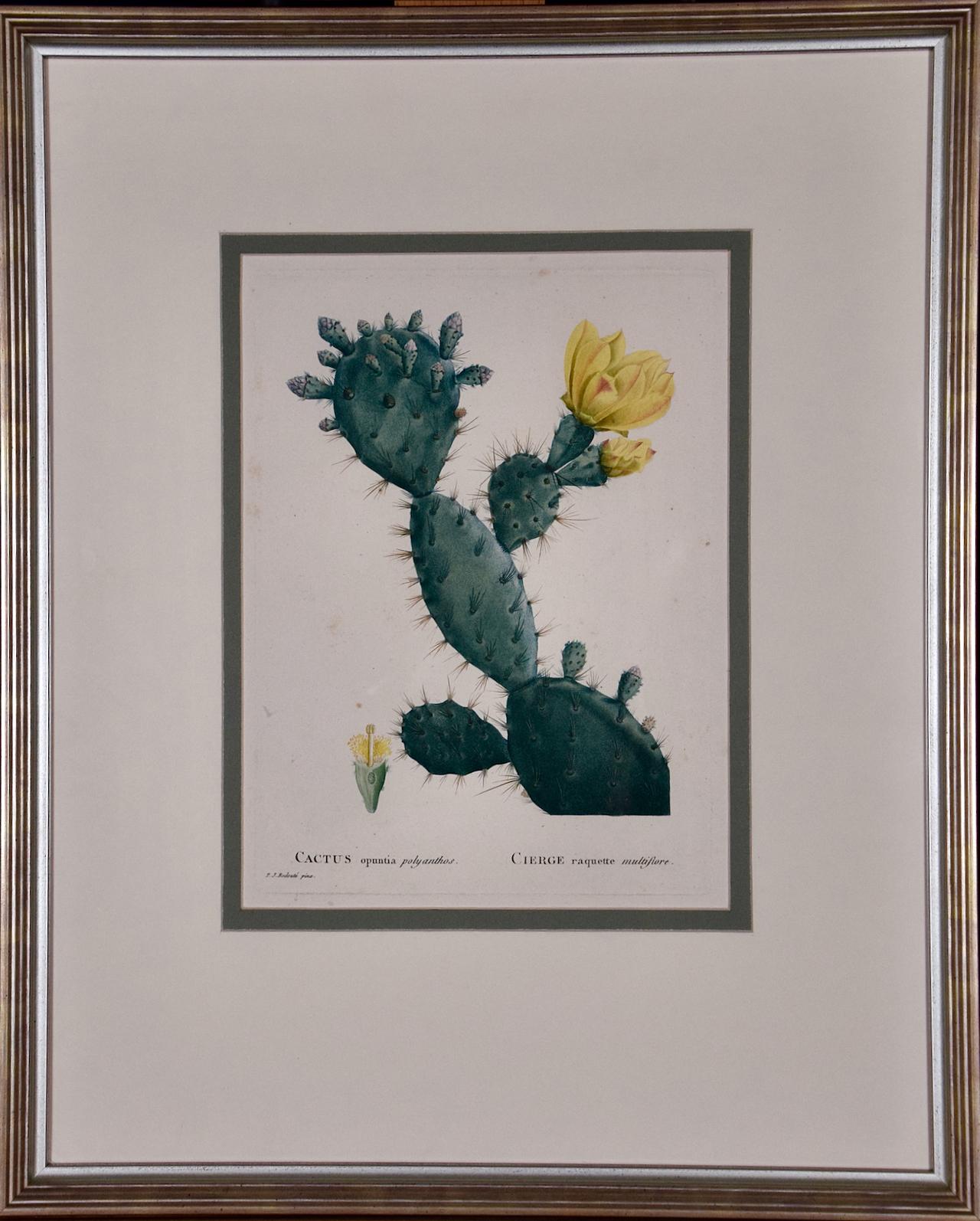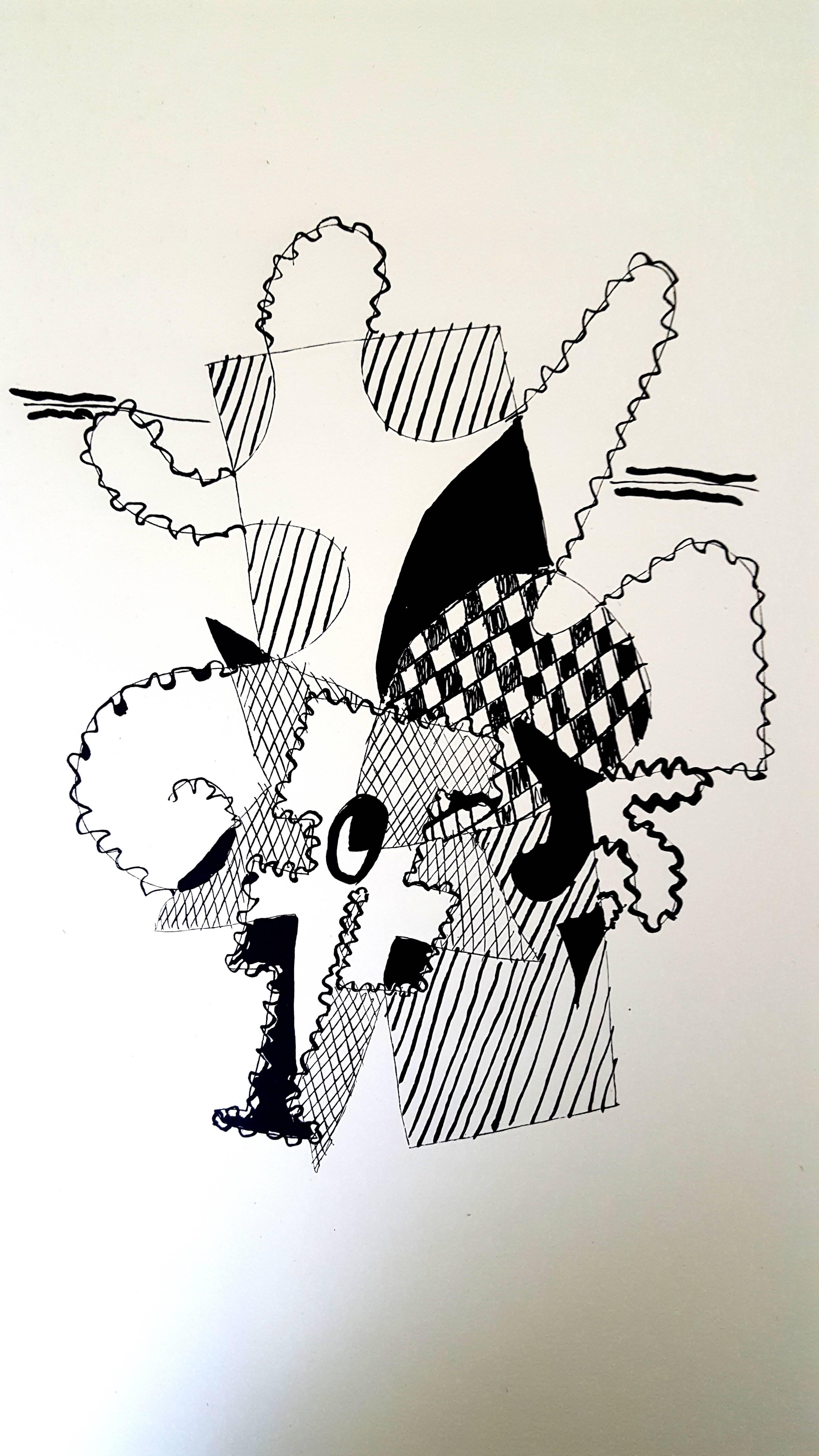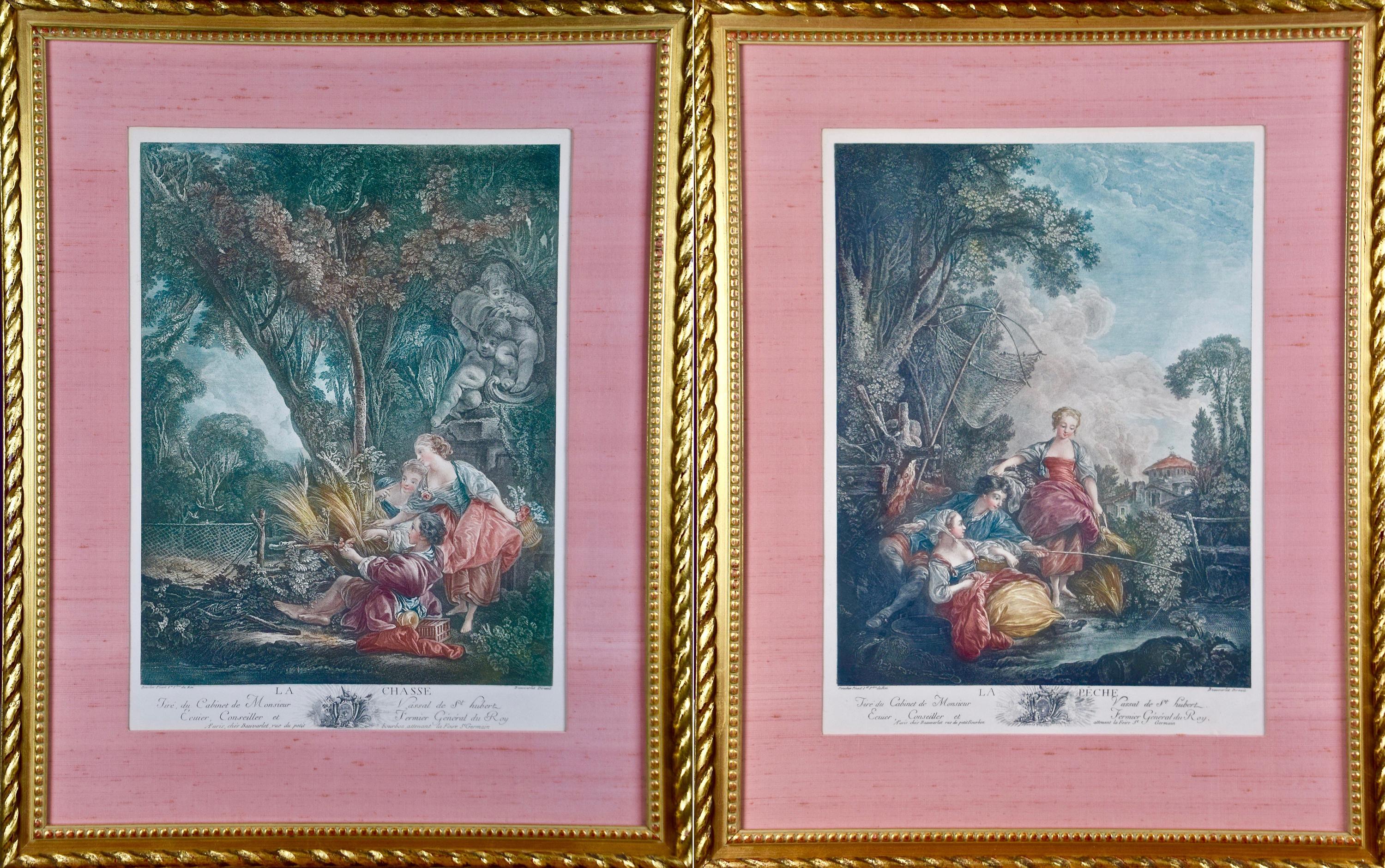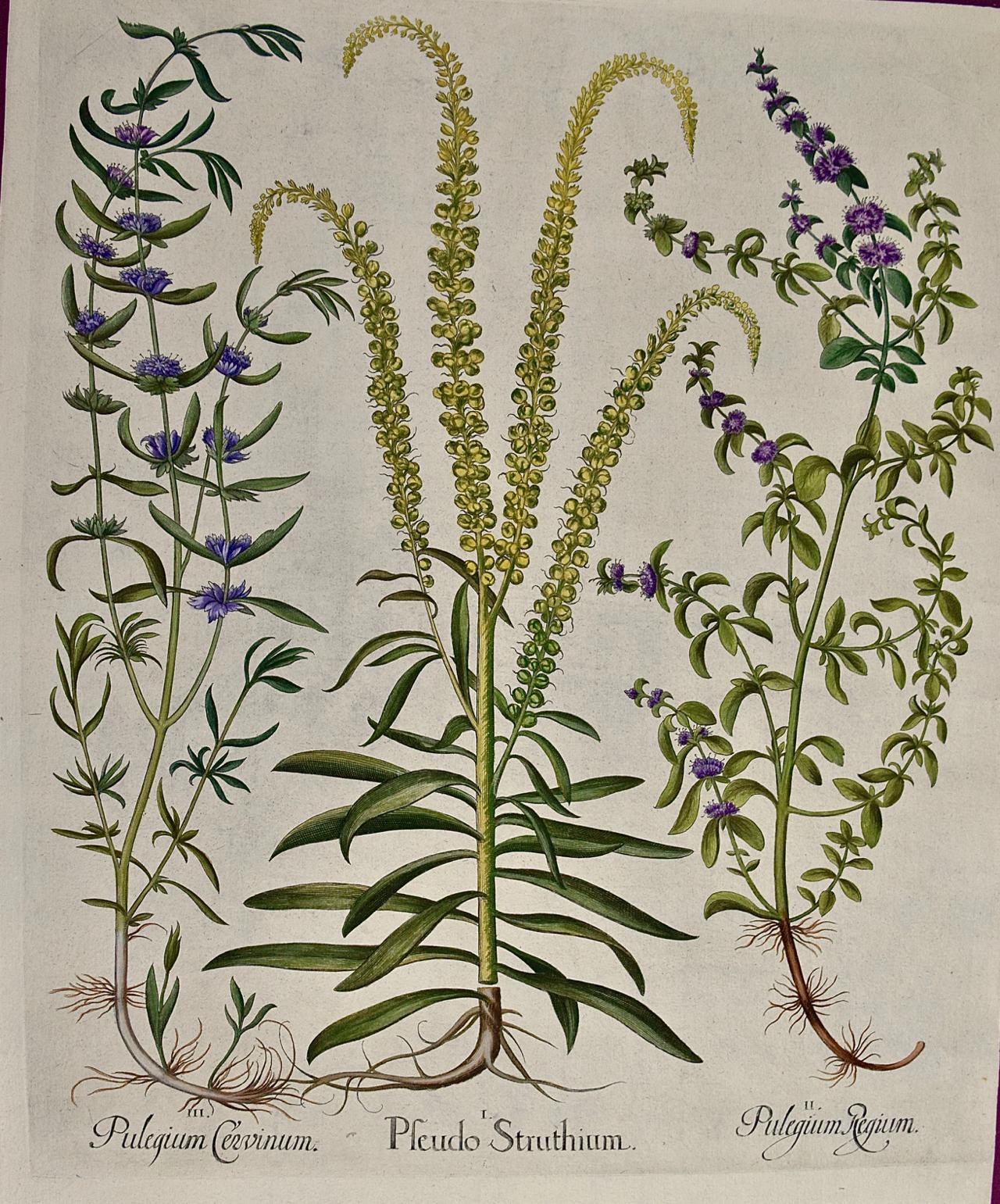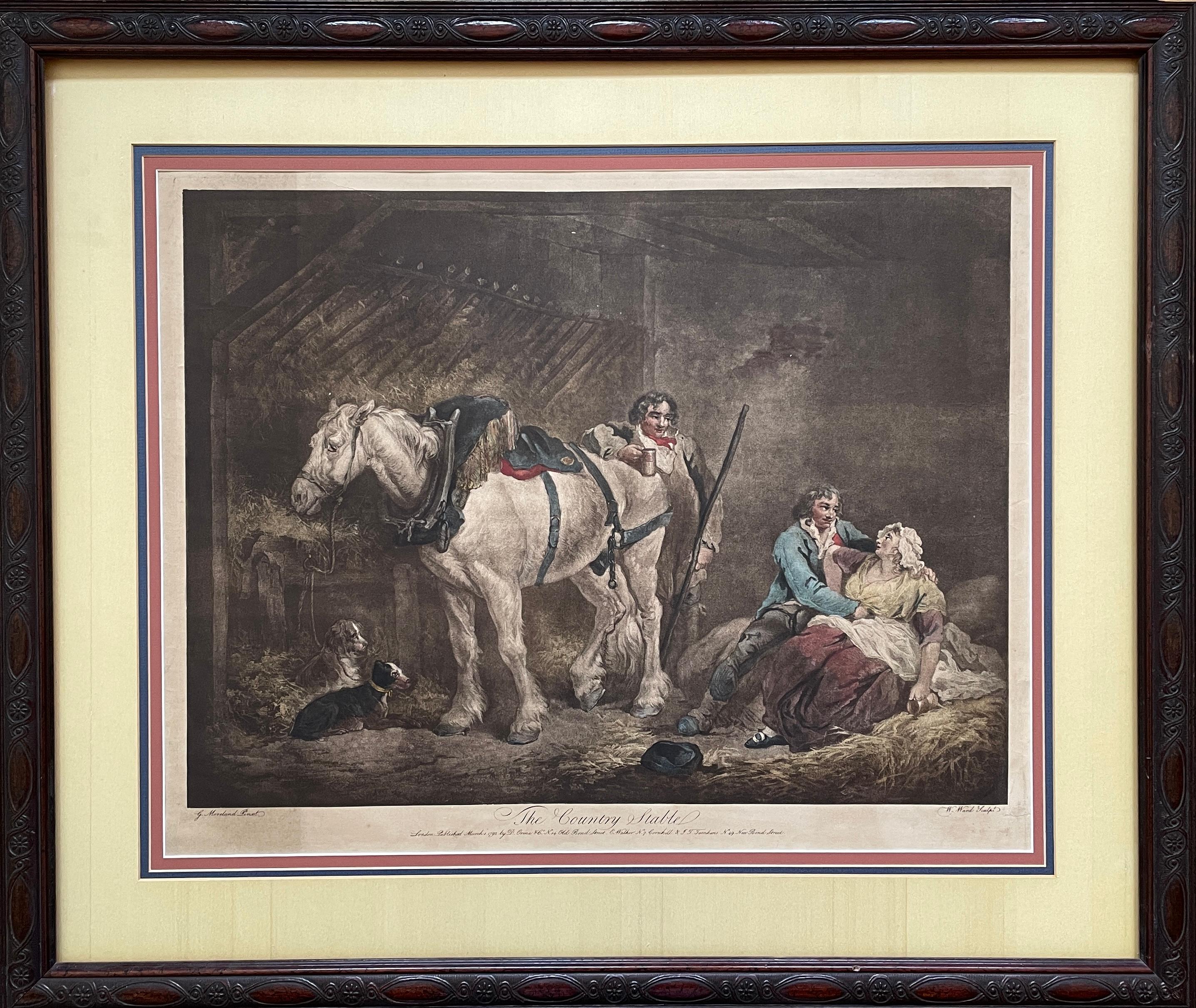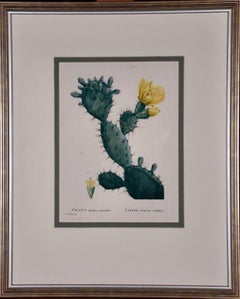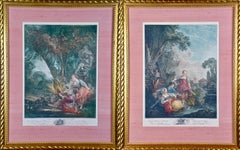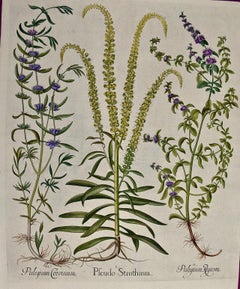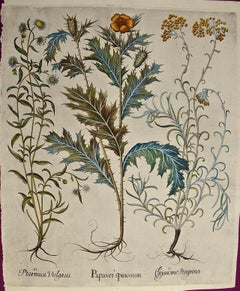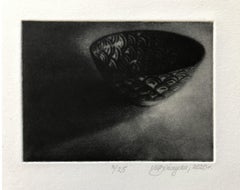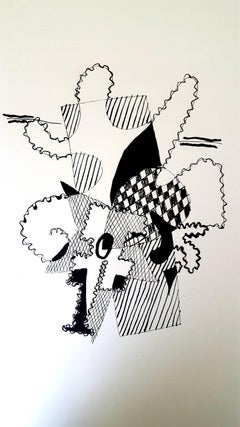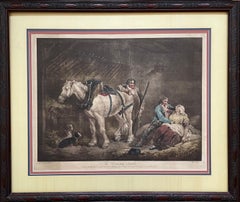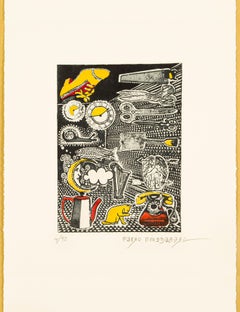Items Similar to Redoute Hand-colored Engraving of Cactus Flowers "Cactus Peruvianus Cierge"
Want more images or videos?
Request additional images or videos from the seller
1 of 11
Pierre-Joseph RedoutéRedoute Hand-colored Engraving of Cactus Flowers "Cactus Peruvianus Cierge"1799
1799
About the Item
This framed hand-colored stipple engraving entitled "Cactus Peruvianus Cierge du Pérou" by Pierre-Joseph Redouté, Plate 58 from his illustrated publication 'Plantarum Historia Succulentarum ou Histoire des Plantes Grasses', published in Paris in 1799. It depicts a branching limb of a cactus with a beautiful flower. There is a separate detail of the anatomy of a seed with early growth. Redoute was a pioneer of the stipple engraving technique, which he used to create this image. It involves utilizing a series of small dots worked into a copper plate rather than the more common lines. These dots can be made smaller or thicker depending on the degree of opacity the artist intends for various areas of the print. When inked and applied to paper, this allows for a greater portion of the paper to be seen, which accentuates the appearance of luminosity of the subject the artist is creating. Different color inks are used in the printing process, a time consuming technique known as "a la poupee". The engraving is then finished with watercolor to further enhance the beauty and realism of the print subject.
This engraving of a flowering cactus is presented in silver-colored ribbed wood frame and a double mat; cream-colored outer mat and heather green inner mat. The frame measures 21.25" high by 17.25" wide by 1.13" deep. The sheet measures 19.88" high by 14" wide. There are wide margins with a few short tears and chips along the the left, right and upper edges, which are all covered by the mat. There are small spots predominantly in the margins, with a few present in the image area. The print is otherwise in very good condition. There is another Redoute flowering cactus listed on 1stdibs, LU117326853392, which is framed and matted identically to this one. The pair would make an attractive display grouping.
Pierre-Joseph Redouté (1759-1840), was a painter and botanist originally from Belgium, who pursued his extremely successful artistic career in France. He is well known for his watercolor paintings of roses, lilies and other flowers and their subsequent folio-sized, color stipple engravings. Some believe him to be the greatest botanical illustrator of all time. Redouté was a favorite of the French royal court at the time and of the post French revolution aristocracy. He was an official court artist of Queen Marie Antoinette and his works continued to be in demand during and after the French Revolution and Reign of Terror. He combined great artistic skills with a pleasing, ingratiating personality which assisted him with his influential patrons. After the fall of the French monarchy, he was a favorite Empress Joséphine, Napoleon Bonaparte's wife and later by his second wife Marie Louise, Duchess of Parma. The wife of Louis Philippe I, the last king of France, Maria Amalia of Naples and Sicily, was also a patron.
- Creator:Pierre-Joseph Redouté (1759 - 1840, French)
- Creation Year:1799
- Dimensions:Height: 21.25 in (53.98 cm)Width: 17.25 in (43.82 cm)Depth: 1.13 in (2.88 cm)
- Medium:
- Movement & Style:
- Period:
- Condition:
- Gallery Location:Alamo, CA
- Reference Number:Seller: # 33611stDibs: LU117326854582
Pierre-Joseph Redouté
Pierre-Joseph Redouté (1759-1840), was a painter and botanist originally from Belgium, who pursued his extremely successful artistic career in France. He is well known for his watercolor paintings of roses, lilies and other flowers and their subsequent folio-sized, color stipple engravings. Some believe him to be the greatest botanical illustrator of all time. Redouté was a favorite of the French royal court at the time and of the post French revolution aristocracy. He was an official court artist of Queen Marie Antoinette and his works continued to in demand during and after the French Revolution and Reign of Terror. He combined great artistic skills with a pleasing, ingratiating personality which assisted him with his influential patrons. After the fall of the French monarchy, he was a favorite Empress Joséphine, Napoleon Bonaparte's wife and later by his second wife Marie Louise, Duchess of Parma. The wife of Louis Philippe I, the last king of France, Maria Amalia of Naples and Sicily, was also a patron.
About the Seller
5.0
Platinum Seller
Premium sellers with a 4.7+ rating and 24-hour response times
Established in 2011
1stDibs seller since 2019
281 sales on 1stDibs
Typical response time: 2 hours
- ShippingRetrieving quote...Shipping from: Alamo, CA
- Return Policy
Authenticity Guarantee
In the unlikely event there’s an issue with an item’s authenticity, contact us within 1 year for a full refund. DetailsMoney-Back Guarantee
If your item is not as described, is damaged in transit, or does not arrive, contact us within 7 days for a full refund. Details24-Hour Cancellation
You have a 24-hour grace period in which to reconsider your purchase, with no questions asked.Vetted Professional Sellers
Our world-class sellers must adhere to strict standards for service and quality, maintaining the integrity of our listings.Price-Match Guarantee
If you find that a seller listed the same item for a lower price elsewhere, we’ll match it.Trusted Global Delivery
Our best-in-class carrier network provides specialized shipping options worldwide, including custom delivery.More From This Seller
View AllFlowering Cactus: Redoute Hand-colored Engraving "Cactus Opuntia Polyanthos"
By Pierre-Joseph Redouté
Located in Alamo, CA
This hand colored stipple engraving entitled "Cactus Opuntia Polyanthos, Cierge Raquette Multiflore" by Pierre-Joseph Redouté, Plate 59 from his illustrated publication 'Plantarum Historia Succulentarum ou Histoire des Plantes Grasses', published in Paris in 1799. Redoute was a pioneer of the stipple engraving technique, which he used to create this image. It involves utilizing a series of small dots worked into a copper plate rather than the more common lines. These dots can be made smaller or thicker depending on the degree of opacity the artist intends for various areas of the print. When inked and applied to paper, this allows for a greater portion of the paper to be seen, which accentuates the appearance of luminosity of the subject the artist is creating. Different color inks are used in the printing process, a time consuming technique known as "a la poupee". The engraving is then finished with watercolor to further enhance the beauty and realism of the print subject.
This engraving of a flowering cactus is presented in a double mat; white outer mat and heather green inner mat.The mat measures 20" x 16" and the sheet measures 19.5" x 13.38". There are wide margins with a few short tears and chips along the the right and upper edges, which are all covered by the mat. There are small spots predominantly in the margins, but a few are present in the image area, but the print is otherwise in very good condition. There is another Redoute flowering cactus listed on 1stdibs, LU117326854582. The pair would make an attractive display grouping.
Pierre-Joseph Redouté (1759-1840), was a painter and botanist originally from Belgium, who pursued his extremely successful artistic career in France. He is well known for his watercolor paintings of roses, lilies and other flowers and their subsequent folio-sized, color stipple engravings. Some believe him to be the greatest botanical illustrator of all time. Redouté was a favorite of the French royal court at the time and of the post French...
Category
Late 18th Century Naturalistic Still-life Prints
Materials
Engraving
Pair of Hand-colored Romantic French Engravings after Francois Boucher
By (After) Francois Boucher
Located in Alamo, CA
A pair of French classical romantic prints original created in the 18th century by Jacques-Firmin Beauvarlet (1731-1797) after paintings by Francois Boucher (1703-1770), utilizing ...
Category
18th Century Romantic Figurative Prints
Materials
Engraving, Etching
Flowering Peppermint Plants: A 17th C. Besler Hand-colored Botanical Engraving
Located in Alamo, CA
This is a hand-colored copper plate engraving entitled "Pulegium Cervinum, Pseudo Pulegium Struthium, Pulegium Regium", depicting flowering Peppermint, Weld and Pennyroyal plants respectively from Basilius Besler's landmark work, Hortus Eystettensis (Garden at Eichstatt), first published in 1613 in Eichstatt, Germany near Nuremberg and later in 1640 and 1713.
This beautiful colorful engraving is printed on thin laid chain-linked paper. There are subtle creases in the right upper corner, very common with Besler's relating to the drying of the paper during its production. The right margin is thinner than the others. The print is otherwise in excellent condition with striking hand-coloring.
Basilius Besler (1561–1629) was an apothecary and botanist. He was curator of the Willibaldsburg Castle garden of Johann Konrad von Gemmingen, prince bishop...
Category
1640s Academic Still-life Prints
Materials
Engraving
Sneezewort, Poppy, Strawflower: 17th C. Besler Hand-colored Botanical Engraving
Located in Alamo, CA
This is a hand-colored copper plate engraving entitled "Ptarmica Vulgaris (Sneezewort), Papaver Spinosum (Mexican Poppy), Chrysocame Peregrina (Seaside Strawflower)", depicting flowering Sneezewort, Mexican Poppy and Seaside Strawberry plants respectively from Basilius Besler's landmark work, Hortus Eystettensis (Garden at Eichstatt), first published in 1613 in Eichstatt, Germany near Nuremberg and later in 1640 and 1713.
This beautiful colorful engraving is printed on thin laid chain-linked paper. The left margin is thinner than the others and the left edge is somewhat irregular where the engraving was previously bound in the original publication. The print is otherwise in excellent condition with striking hand-coloring. The sheet measures 20" high and 16.38" wide.
Basilius Besler (1561–1629) was an apothecary and botanist. He was curator of the Willibaldsburg Castle garden of Johann Konrad von Gemmingen, prince bishop...
Category
1640s Academic Still-life Prints
Materials
Engraving
Flowering Hyacinth & Calla Plants: A Besler Hand-colored Botanical Engraving
Located in Alamo, CA
This is a hand-colored copper plate engraving depicting flowering "Hyacinthus Comosus Spurius" (Hyacinth), "Hyacinthus Anglicus" (Blue Hyacinth), "Palma ...
Category
Early 18th Century Academic Still-life Prints
Materials
Engraving
Buttercup Flowers: A Besler 18th Century Hand-colored Botanical Engraving
Located in Alamo, CA
This is a hand-colored copper plate engraving depicting Ranunculus (Persian Buttercup) flowers from Basilius Besler's landmark work, Hortus Eystettensis (Garden at Eichstatt), first published in 1613 in Eichstatt, Germany near Nuremberg and later in 1640 and 1713.
This beautiful colorful engraving is printed on thick laid chain-linked paper. There is latin text on the verso. There are central horizontal creases and two small holes on the right and another in the left lower corner. It is otherwise in excellent condition.
Basilius Besler (1561–1629) was an apothecary and botanist. He was curator of the Willibaldsburg Castle garden of Johann Konrad von Gemmingen, prince bishop...
Category
Early 18th Century Academic Still-life Prints
Materials
Engraving
You May Also Like
Seigaiha wave - Contemporary Figurative Print, Monochromatic, Still life
Located in Warsaw, PL
Edition of 25, signed, numbered
AGNIESZKA LECH-BIŃCZYCKA
Graduated from University of Rzeszów in a field of Artistic Education with specialisation in g...
Category
2010s Contemporary Figurative Prints
Materials
Paper, Mezzotint
Pablo Picasso (after) Helene Chez Archimede - Wood Engraving
By (after) Pablo Picasso
Located in Collonge Bellerive, Geneve, CH
Pablo Picasso (after)
Helene Chez Archimede
Medium: engraved on wood by Georges Aubert
Dimensions: 44 x 33 cm
Portfolio: Helen Chez Archimede
Year: 1955
Edition: 240 (Here it is on...
Category
1950s Cubist Figurative Prints
Materials
Engraving
$1,021 Sale Price
20% Off
"The Country Stable" 18th Century Antique Mezzotint Engraving by William Ward
By George Morland
Located in Carmel, CA
"The Country Stable" After a painting by George Morland. 1763-1804. - Mezzotint engraving by William Ward. 1766-1826.
Print: 20.75" x 26" - With Frame: 28.5" x 34"
Published: March...
Category
Late 18th Century Realist Still-life Prints
Materials
Engraving, Mezzotint
"Herramientas y más" contemporary engraving surrealist tools objects
By Pedro Friedeberg
Located in Ciudad de México, MX
The repetition of patterns and rhythm is present in almost every piece of Pedro´s work.
The hybrid topographies that Pedro Friedeberg´s unclassifiable practice recreates we must rec...
Category
21st Century and Contemporary Surrealist Figurative Prints
Materials
Engraving
Cherry - Etching on Paper by Mario Avati - 1960s
By Mario Avati
Located in Roma, IT
Cherry is etching on paper, realized by the French artist and print-maker master Mario Avati (1921-2009).
Hand-signed on the lower right and numbered on the lower left in pencil. Ed...
Category
1960s Figurative Prints
Materials
Mezzotint, Etching
Elephant and Pears - Original Etching on Paper by Mario Avati - 1970s
By Mario Avati
Located in Roma, IT
Elephant and Pears is original etching on paper, realized by the French artist and print-maker master Mario Avati (1921-2009).
Hand-signed on the lower right and numbered on the low...
Category
1970s Figurative Prints
Materials
Etching, Mezzotint
Recently Viewed
View AllMore Ways To Browse
Hand Colored Engraving Print
Hand Colored French Engravings
Life Of Napoleon
Antique Copper Still
Pair Of Framed Engraving
Pair Of French Engravings
Hand Colored Copper Engraving
Wood Cactus
Pair Botanical Prints
Napoleon And Josephine
Napoleon Wood Painting
Marie Antoinette Silver
Napoleon And Marie Louise
Copper Cactus
